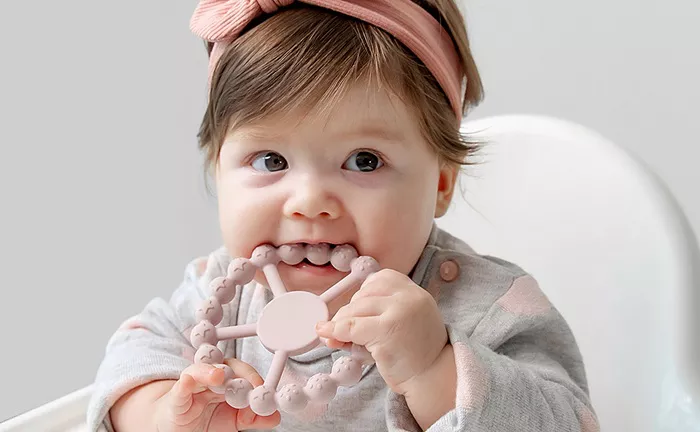A teether is a special toy designed for babies who are going through the teething process. When babies start to grow their first teeth, their gums can become sore and uncomfortable. A teether helps soothe this discomfort by giving babies something safe to chew on. Unlike pacifiers, which are meant to be sucked, teethers are made to be chewed. They come in many shapes, sizes, and materials, such as silicone, wood, or rubber. Some teethers even contain a gel or liquid that can be cooled in the fridge or freezer to provide extra relief.
Why Do Babies Need Teethers?
Babies often put things in their mouths, especially when they are teething. This is because chewing on objects helps relieve the pain and pressure caused by new teeth pushing through the gums. Signs that a baby is teething include drooling, fussiness, swollen gums, and sometimes a mild fever. Offering a teether can help calm a baby and reduce these symptoms.
Benefits of Using a Teether
Reduces Pain: Chewing on a teether can ease the soreness in a baby’s gums by applying gentle pressure.
Relieves Swollen Gums: The biting action helps reduce the feeling of swollen gums and makes babies more comfortable.
Provides Entertainment: Teethers keep babies busy and distracted, which can help reduce crankiness.
Supports Oral Motor Development: Chewing strengthens the muscles in the mouth, including the jaw, lips, and tongue, which are important for eating and speaking later on.
Encourages Sensory Exploration: Babies learn about different textures and sensations by chewing on teethers, helping their sensory skills develop.
Materials and Types of Teethers
Teethers come in various materials, each with its own advantages:
Silicone: Soft, flexible, and easy to clean. Most modern teethers are made from food-grade silicone.
Wood: Natural and firm, wooden teethers provide a different texture that some babies enjoy.
Rubber: Soft and chewable, rubber teethers are gentle on gums.
Gel or Liquid-Filled: These teethers can be cooled to provide a soothing cold sensation, but parents should ensure they are intact to avoid leaks.
How to Use a Teether Safely
When giving a baby a teether, safety is very important. Here are some tips:
- Choose teethers made from non-toxic, BPA-free materials.
- Inspect the teether regularly for signs of wear or damage.
- Avoid teethers with small parts that could come off and pose a choking hazard.
- Clean teethers often to prevent bacterial buildup.
- Do not use teething necklaces or bracelets, as they can be dangerous and have been recalled in some cases.
The Role of Teethers in Development
Teethers do more than just ease pain. They help babies develop important skills:
Oral Motor Development
Chewing on a teether helps build strength and coordination in the mouth muscles. These muscles are essential for chewing food, swallowing safely, and later speaking clearly. The repetitive motion of biting and chewing also helps babies learn how to control their tongue and lips.
Desensitizing the Gag Reflex
Some babies have a sensitive gag reflex, which can make feeding difficult. Using a teether can gently stimulate the mouth and help babies get used to different sensations, reducing this sensitivity over time.
Encouraging Exploration
Babies use their mouths to explore the world. Teethers offer a safe way for them to touch, taste, and feel different textures. This sensory play supports brain development and helps babies learn about their environment.
When to Introduce a Teether
Most babies start teething between 4 to 7 months old, but it can vary. You can offer a teether as soon as your baby shows signs of teething, such as increased drooling or fussiness. Introducing a teether early can provide comfort and support during this challenging time.
Choosing the Right Teether
When selecting a teether, consider the following:
Age Appropriateness: Make sure the teether is suitable for your baby’s age and developmental stage.
Texture and Shape: Different textures help with sensory development. Shapes that are easy to hold encourage motor skills.
Ease of Cleaning: Choose teethers that can be easily washed or sterilized.
Cooling Option: If your baby likes cold relief, consider gel-filled or water-filled teethers that can be chilled.
Alternatives to Teethers
Besides teethers, some parents use teething biscuits or rusks. These are edible and help babies chew safely. However, always supervise your baby when giving any food to avoid choking risks.
Conclusion
A teether is a simple but effective tool to help babies through the teething process. It soothes sore gums, supports oral motor skills, and provides sensory stimulation. Choosing a safe, age-appropriate teether and using it properly can make teething easier for both babies and parents. Remember to keep teethers clean and inspect them regularly to ensure safety. With the right teether, your baby can enjoy comfort and developmental benefits during this important stage of growth.
Related topics:


